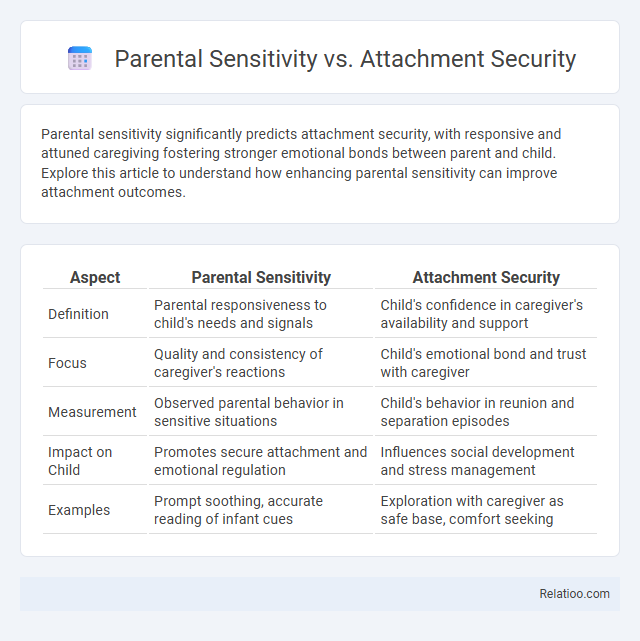Parental sensitivity significantly predicts attachment security, with responsive and attuned caregiving fostering stronger emotional bonds between parent and child. Explore this article to understand how enhancing parental sensitivity can improve attachment outcomes.
Table of Comparison
| Aspect | Parental Sensitivity | Attachment Security |
|---|---|---|
| Definition | Parental responsiveness to child's needs and signals | Child's confidence in caregiver's availability and support |
| Focus | Quality and consistency of caregiver's reactions | Child's emotional bond and trust with caregiver |
| Measurement | Observed parental behavior in sensitive situations | Child's behavior in reunion and separation episodes |
| Impact on Child | Promotes secure attachment and emotional regulation | Influences social development and stress management |
| Examples | Prompt soothing, accurate reading of infant cues | Exploration with caregiver as safe base, comfort seeking |
Understanding Parental Sensitivity
Parental sensitivity refers to a caregiver's ability to accurately perceive, interpret, and respond to their child's emotional and physical needs in a timely and appropriate manner. It is a critical factor influencing attachment security, as sensitive parenting fosters a secure attachment by promoting trust and emotional regulation in the child. Research indicates that enhancing parental sensitivity through targeted interventions can significantly improve attachment outcomes and overall child development.
Defining Attachment Security
Attachment security refers to the child's confidence in the availability and responsiveness of their caregiver, forming a stable emotional bond that supports healthy social and emotional development. Parental sensitivity, which involves accurately perceiving and appropriately responding to your child's cues and needs, is a key predictor of attachment security. This secure attachment fosters trust, emotional regulation, and resilience in children, distinguishing it from general parental responsiveness or sensitivity alone.
The Relationship Between Sensitivity and Attachment
Parental sensitivity, characterized by a caregiver's responsiveness and attunement to an infant's cues, strongly predicts attachment security, fostering a secure base for healthy emotional development. Research shows that higher levels of parental sensitivity correlate with increased attachment security, supporting the child's ability to regulate emotions and explore the environment confidently. This relationship underscores the importance of sensitive caregiving in forming secure attachment bonds that impact long-term psychological well-being.
Key Factors Influencing Parental Sensitivity
Key factors influencing parental sensitivity include responsiveness to infant cues, emotional availability, and consistent caregiving behaviors, which directly impact attachment security in children. Your ability to accurately interpret and respond to your child's signals fosters a secure attachment, promoting healthy emotional and social development. Research highlights that parental stress levels, social support, and cultural practices also play critical roles in shaping sensitivity and subsequent attachment outcomes.
How Attachment Styles Develop in Children
Attachment styles in children develop primarily through variations in parental sensitivity, where consistent and responsive caregiving fosters secure attachment by meeting the child's emotional and physical needs effectively. Parental sensitivity involves accurately perceiving, interpreting, and appropriately responding to a child's signals, forming the foundation for attachment security or insecurity. In contrast, inconsistent or insensitive parenting often leads to insecure attachment styles, impacting the child's emotional regulation and social development.
Measuring Parental Sensitivity and Attachment Security
Measuring parental sensitivity typically involves observational assessments, such as the Ainsworth Sensitivity Scales, which evaluate a caregiver's responsiveness to an infant's cues in naturalistic settings, capturing the timing, appropriateness, and quality of parental responses. Attachment security is commonly measured using the Strange Situation Procedure, a structured laboratory assessment that observes a child's behavior during separations and reunions with the caregiver to classify attachment styles (secure, avoidant, resistant, disorganized). Parental sensitivity is considered a key predictor of attachment security, with empirical studies linking higher sensitivity scores to increased likelihood of secure attachment classifications.
The Impact of Sensitive Parenting on Child Development
Parental sensitivity plays a crucial role in fostering attachment security, which directly influences a child's emotional regulation, social skills, and cognitive development. Your responsive and attuned parenting increases the likelihood of secure attachment, promoting resilience and healthy interpersonal relationships throughout childhood. Research consistently shows that sensitive caregiving enhances brain development and supports positive mental health outcomes in children.
Cultural Influences on Sensitivity and Attachment
Parental sensitivity, characterized by timely and appropriate responses to a child's needs, directly influences attachment security, which reflects the child's sense of safety and trust in the caregiver. Cultural factors shape how sensitivity is expressed and perceived, with practices varying widely across societies, impacting the formation and stability of attachment bonds. Understanding cultural nuances is essential for interpreting caregiving behaviors and their effects on attachment security within diverse familial contexts.
Enhancing Parental Sensitivity: Strategies and Tips
Enhancing parental sensitivity involves recognizing and appropriately responding to a child's emotional and physical needs, which significantly strengthens attachment security. Strategies include active listening, observing nonverbal cues, and maintaining consistent, nurturing interactions that promote trust and emotional regulation. Implementing responsive caregiving practices fosters secure attachment by ensuring children feel understood and supported in their developmental environment.
Long-Term Outcomes of Secure vs Insecure Attachment
Secure attachment in early childhood, fostered through high parental sensitivity, is strongly linked to optimal long-term outcomes such as enhanced emotional regulation, social competence, and academic success. Insecure attachment, often resulting from inconsistent or low parental sensitivity, correlates with increased risks of anxiety, behavioral problems, and difficulties in forming healthy relationships later in life. Longitudinal studies highlight that parental sensitivity not only shapes attachment security but also serves as a critical determinant of child developmental trajectories across multiple domains.

Infographic: Parental sensitivity vs Attachment security
 relatioo.com
relatioo.com